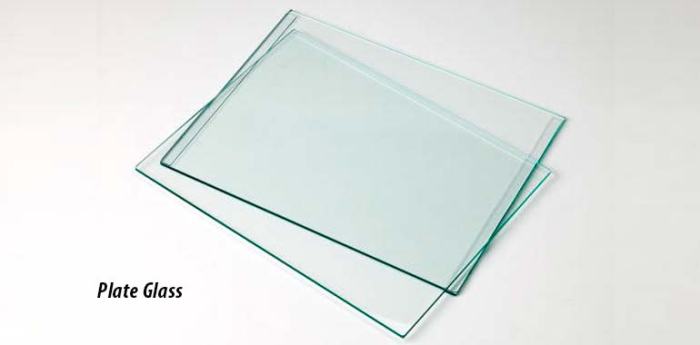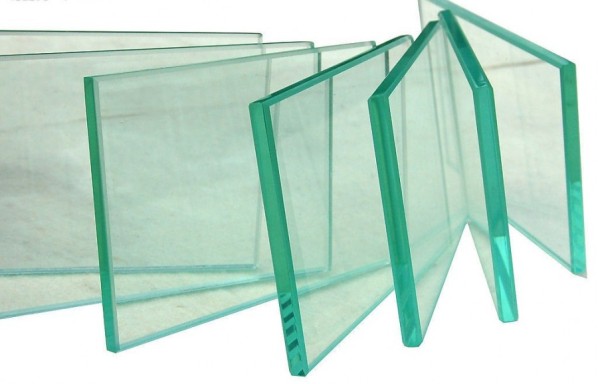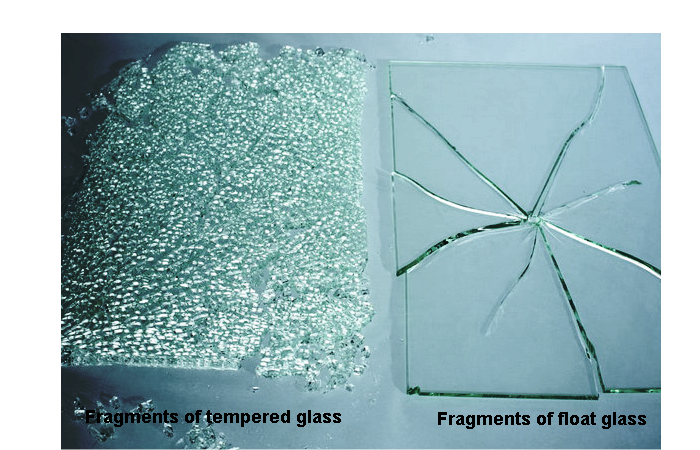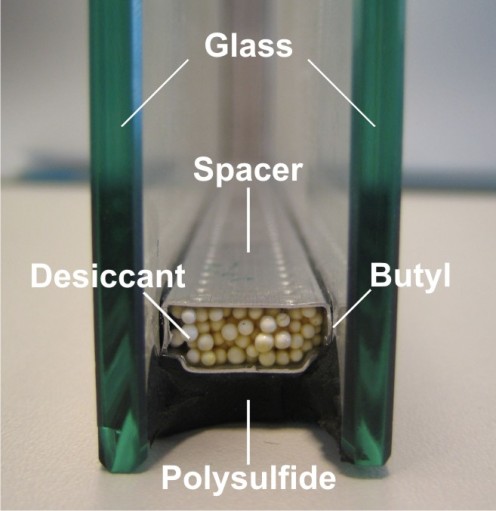Glass is a rigid, chemically inert, and brittle material made by fusing together silica (silicon-dioxide) with a flux and a stabilizer into a substance which cools in a rigid form without crystallizing. Sand is mixed with soda ash, lime, and smaller amounts of potassium-oxide, alumina, and then heated.
Despite it’s solid appearance, glass is a non-crystalline microstructure and even considered by some an extremely slow moving liquid. Glass is manufactured into standard thicknesses ranging from 3/32″ to 1″ or more. Glass thickness is dependent on the size of the ‘lite’ (pane) and the anticipated wind loads. Small buildings with small windows, 1/8″ thickness is adequate. Glass surfaces are typically numbered starting from the exterior side working inward: example double paned; exterior lite outside facing = 1, exterior lite inward facing = 2, interior lite outside facing = 3, interior lite inward facing = 4.
There are 3 primary types of flat glass based on their fabrication method:
Sheet Glass – Made by drawing molten glass from a furnace (drawn glass) OR shaping it into a cylinder, cutting it lengthwise and flattening it (cylinder glass). Typically 3/32″ (max 60″ x 60″ size) or 1/8″ (60″ x 80″ max size). 1.63 lbs/sf for 1/8″ thickness.

Plate Glass – Made by rolling molten glass into a plate, cooled, then ground and polished. Typically 1/4″ (max area 75 SF) or 1/8″ (max area 60SF). Option for reflective coating available.

Float Glass – Made by pouring molten glass on molten tin and letting it slowly cool. Float glass is the successor to plate glass, typically doesn’t require grinding or polishing, and accounts for the majority of flat glass production. Typically 1/4″ (max area 75 SF) or 1/8″ (max area 60SF). Option for reflective coating available.

Some other types of glasses and product modifications are:
Annealed Glass – slow cooled to relieve internal stresses

Heat-Strengthened Glass – About twice the strength of annealed-only glass, heat-strengthened glass is annealed and part tempered by reheating and sudden cooling.
Tempered Glass – Annealed and reheated just below softening point and then quick cooled to promote a sort of -pre-stressing’ of the edges and interior of the glass. Has 3-5 times the impact/thermal stress resistance of standard annealed glass and when broken, creates harmless pebble sized particles. Must be 1/8″ or thicker. Option for reflective coating available.

Laminated/Safety Glass – Most commonly two plies of flat glass bonded under heat/pressure to sandwich a polyvinyl butyral resin which holds any broken pieces together. Option for reflective coating available. Commonly used in skylights and overhead glazing. Is a comparitively better sound barrier than glass and is better at reducing UV transmission.

Wired Glass – Includes diamond or square wire mesh inside it to prevent shattering. Often used in fire doors and windows. Typically 7/32″, 1/4″, 3/8″ thicknesses (max area 72″ x 120″)

Fire-Rated Glass – WHen a wall has a certain fire rating and requires glass, a fire rated products are available. Some tempered or laminated glasses can achieve a 20 minute rating, while some wired glass can have a 45 minute rating.

Tinted Glass – Iron-Oxide, cobalt-oxide, selenium, or nickel chemical admixtures absorb radiant heat and light. Typically 1/8″, 3/16″, 1/4″

Reflective Glass – Has a metal coating which is translucent and reflects some light and radiant heat.

Plastic Glazing Sheets – Transparent plastic sheets made of acrylic and polycarbonate and is typically more expensive than standard float glass. Expand and contract with temperature changes and bow towards warm side when exposed to higher temperatures. A modified polycarbonate product is typically used for high impact resistance situations.

Insulating Glass – Made of sheet, plate, or float glass Includes two or more sheets of glass kept apart by a hermetically sealed space of air which provides thermal insulation and condensation prevention. Metal edges are typically aluminum, stainless steel, or an advanced thermally broken (aluminum or rubber) material and have a 1/4″ or 1/2″ air space. Agron and Krypton gases (greater density and lower thermal conductivity than air) are typically sealed in the airspace and improve the thermal performance 15-20%. Dessicant (drying agent) is typically included in the air space to eliminate any trapped moisture after sealing (moisture inside the panes indicate seal failure). U-Factor is used to measure thermal insulation performance (BTU / ft squared-hr-Fahrenheit) and is the mathematical reciprocal (lower values are better) of R-Value. Typically 3/32″, 1/8″, 3/16″, 1/4″. Can produce R-Values of 2-3 and e values of 0.60 to 0.20. Option for reflective coating available.



Low Emmissivity Glass (Low-E) – Allows passage of visible light but reflects radiant heat longer wavelengths. Has low Infrared radiation transmittanceand reduces radiant heat transfer between lites. Double-glazed low-E glass typically outperforms standard triple pane windows in terms of thermal performance. The coating is applied over the glass directly or over a see through plastic film in the sealed air space of the glass.

Single Glazing Clear – U = 1.1, R = 0.91
Double Glazing Clear – U = 0.47, R = 2.1
Triple Glazing Clear – U = 0.34, R = 2.9
Double Glazing Clear (Low-E) – U = 0.28, R = 3.6